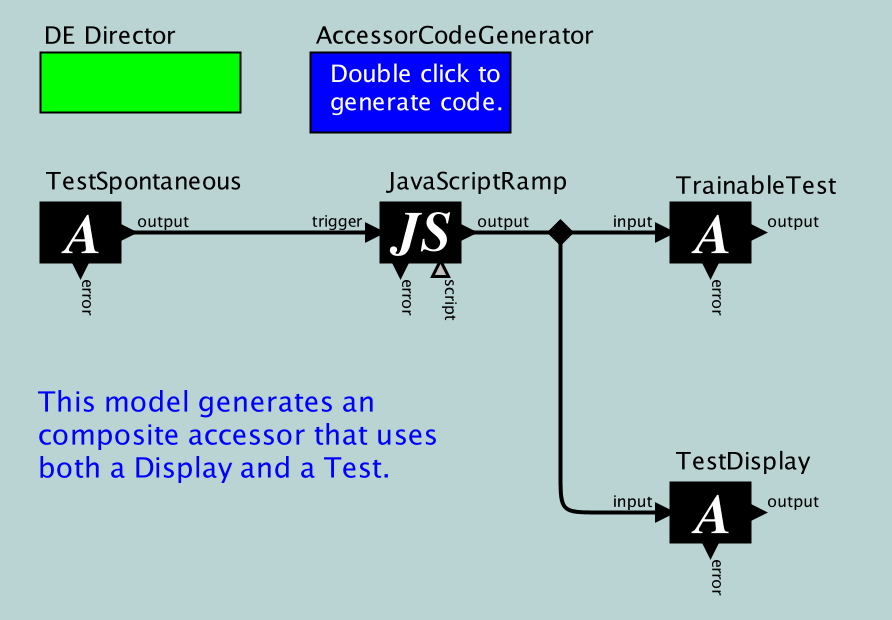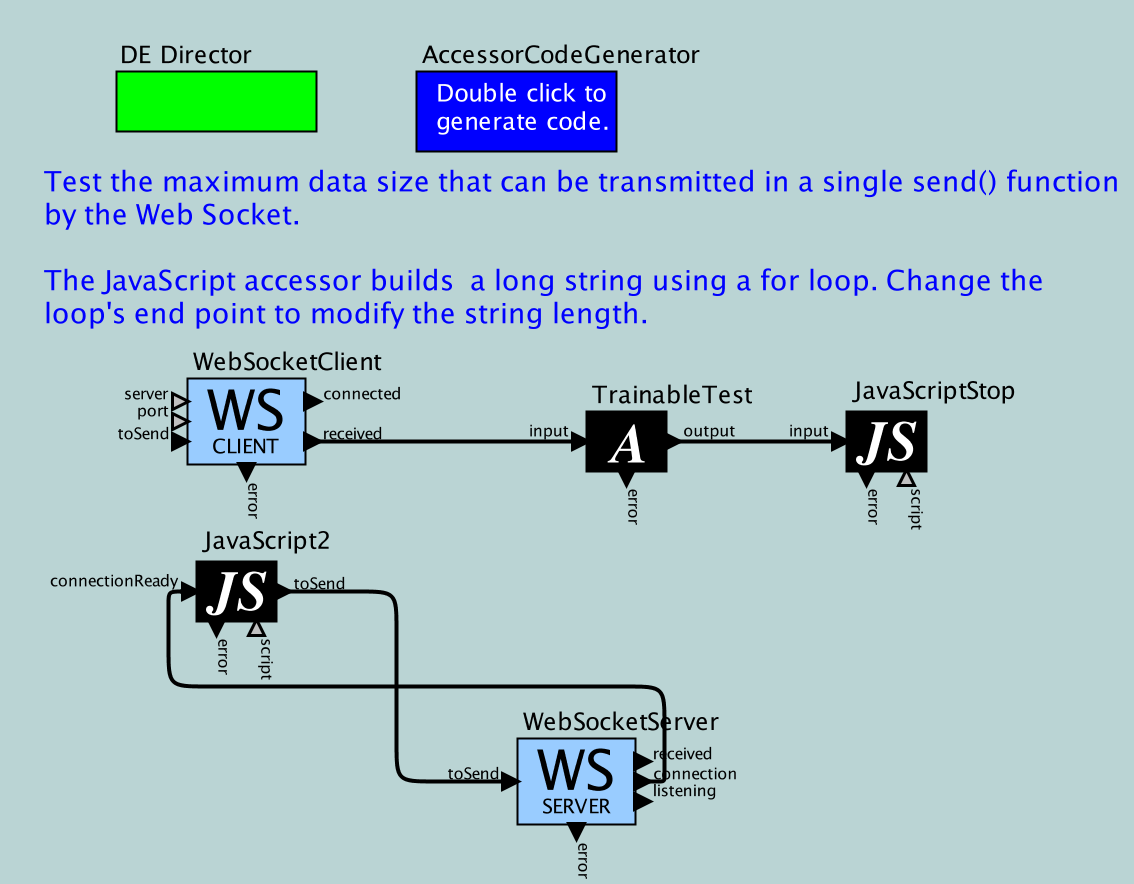
|
Main /
CompositeAccessor(redirected from Main.CompositeAccessors) A composite accessor is a .js file that defines a Container that contains one or more connected accessors. A composite accessor is a type of Swarmlet. All of the Accessor Hosts should be able to execute a composite accessor, though not all the Accessor hosts define all the modules that can be used in the accessors. In otherwords, it is possible to define a composite accessor that will not run on all accessor hosts because the composite accessor uses accessors that use modules that are not defined on all accessor hosts. Below is JavaScript for composite accessor that consists of a TestSpontaneous accessor connected to a JavaScriptRamp which is the connected to both a TestDisplay and a TrainableTest. This composite accessor should work on all accessor hosts because the accessors do not use accessor host-specific modules. The implementation of the JavaScriptRamp actor is contained within the composite accessor, whereas the implementation of the other accessors are downloaded from the accessors website. exports.setup = function() { var TestSpontaneous = this.instantiate('TestSpontaneous', 'test/TestSpontaneous.js'); TestSpontaneous.setParameter('interval', 1000.0); var JavaScriptRamp = new Accessor('JavaScriptRamp', '/** Output a sequence with a given step in values.\n *\n * @accessor test/TestRamp\n * @param init The value produced on its first iteration. The\n * initial default is 0.\n * @input trigger The trigger\n * @output output The output\n * @param step The amount by which the output is incremented. The\n * default is 1.\n * @author Christopher Brooks\n * @version $$Id: RampJSTestDisplay.xml 74761 2016-04-28 01:13:33Z cxh $$\n */\nexports.setup = function() {\n // FIXME: this only supports numbers, unlike the Cape Code Ramp\n // actor, which supports many types.\n this.parameter(\'init\', {\'type\':\'number\', \'value\':0});\n this.input(\'trigger\');\n this.output(\'output\', {\'type\':\'number\'});\n this.parameter(\'step\', {\'type\':\'number\', \'value\':1});\n};\n\nvar _lastValue = 0;\n\nexports.initialize = function() {\n _lastValue = this.getParameter(\'init\');\n}\nexports.fire = function() {\n _lastValue += this.getParameter(\'step\');\n this.send(\'output\', _lastValue);\n};', null, null, null, null); JavaScriptRamp.container = this; this.containedAccessors.push(JavaScriptRamp); JavaScriptRamp.setParameter('init', 0.0); JavaScriptRamp.setParameter('step', 1.0); var TestDisplay = this.instantiate('TestDisplay', 'test/TestDisplay.js'); var TrainableTest = this.instantiate('TrainableTest', 'test/TrainableTest.js'); TrainableTest.setParameter('correctValues', [1,2,3,4,5]); TrainableTest.setParameter('trainingMode', false); TrainableTest.setParameter('tolerance', 1.0E-9); this.connect(TestSpontaneous, 'output', JavaScriptRamp, 'trigger'); this.connect(JavaScriptRamp, 'output', TestDisplay, 'input'); this.connect(JavaScriptRamp, 'output', TrainableTest, 'input'); } A version of the above with more comments may be found at https://ptolemy.berkeley.edu/accessors/test/auto/RampJSTestDisplay.js This composite accessor should run under all accessor hosts. Running a composite accessor in Node.jsTo run a composite accessor in Node.js: bash-3.2$ cd /Users/cxh/ptII/org/terraswarm/accessor/accessors/web/test/auto bash-3.2$ node ../../hosts/node/nodeHostInvoke.js -timeout 6000 test/auto/RampJSTestDisplay Reading accessor at: /Users/cxh/ptII/org/terraswarm/accessor/accessors/web/test/auto/RampJSTestDisplay.js Reading accessor at: /Users/cxh/ptII/org/terraswarm/accessor/accessors/web/test/TestSpontaneous.js Reading accessor at: /Users/cxh/ptII/org/terraswarm/accessor/accessors/web/test/TestDisplay.js Reading accessor at: /Users/cxh/ptII/org/terraswarm/accessor/accessors/web/test/TrainableTest.js Instantiated accessor RampJSTestDisplay with class test/auto/RampJSTestDisplay 1 2 3 4 5 nodeHostInvoke.js: Timeout of 6000 ms. has occurred. About to invoke wrapup(). bash-3.2$ For more information, see Node Host -> Invoking Composite Accessor - The Node Host can invoke a Composite Accessor DuktapeTo invoke the Duktape Host on a composite accessor, do the following: bash-3.2$ cd accessors/web/hosts bash-3.2$ ./duktape/duktape/duk --timeout 5000 --accessor test/auto/RampJSTestDisplay.js duk: About to instantiate test/auto/RampJSTestDisplay.js 1 2 3 4 bash-3.2$ For more information see Duktape Host -> Invoke Composite Accessor - The Duktape Host can invoke a Composite Accessor (as can the other hosts) Cape CodeTo create a composite accessor, one may create a JavaScript file by hand. In addition, the Cape Code Host may be used to create a model that then generates the JavaScript file by hand using Code Generation. The Cape Code model below was used to generate the composite accessor JavaScript file above.  The source model may be found at Below is a more complex Composite Accessor that contains a feedback loop. See Cape Code Zero Delay Loops. The source model may be found at  Starting a Composite Accessor (Spontaneous ports)In a Composite Accessor, to start execution, there are various methods:
Testing using MochaWe use Mocha to test the Node accessor host, see Testing. See Also
|